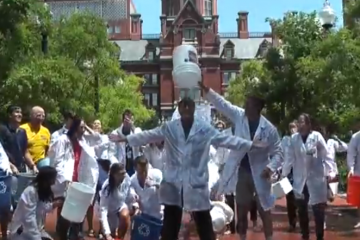ALS researcher Jeff Rothstein wants people to keep throwing cold water.
In the past few weeks, The Ice Bucket Challenge has cycloned through social media circles, creating a global phenomenon that has helped raise awareness and money on an unprecedented level for amyotrophic lateral sclerosis, commonly known as ALS or Lou Gehrig's disease. Not since the Titanic sank has icy water created such worldwide buzz.
As of Aug. 21, the national ALS Association had received $41.8 million in donations compared to $2.1 million during the same time period (July 29 to Aug. 21) a year ago, a near twentyfold increase. A sizable portion of this money has come from more than 739,000 new donors.
The Robert Packard Center for ALS Research at Johns Hopkins, which Rothstein directs, has also been the beneficiary of ice bucket craze. Since Aug. 4—the approximate date the Internet frenzy shifted into high gear—the Packard Center has seen an 800 percent increase in donations compared to the same time period in August 2013. The center's social media and Web traffic are up over 400 percent.
According to Milan Karol, the center's development officer, the actual number of dollars raised is hard to pin down because the donations are coming fast and furious.
"It started out as a tiny trickle, and now they are coming in a steady stream," Karol said. "I would go out for lunch and come back and see 20 to 30 new gifts sent. It's really been a wonderful thing for us."
In case you've been off the grid, here's what The Ice Bucket Challenge is all about. People make videos of themselves dumping a bucket (or crate, or cooler, or bowl) of ice water on their heads and then post it on Facebook, Instagram, YouTube, or another social media channel with some form of the #ALSIceBucketChallenge hashtag. In the video, they challenge friends to do the same within 24 hours. The person can accept or choose to dodge the dousing and donate $100 to an ALS-focused organization or charity. Many are doing both, and the videos—as of Monday, more than 2.4 million related videos had been shared on Facebook alone, according to Facebook's estimates—and donations have grown exponentially.
The challenge has inspired the likes of Katy Perry, George W. Bush, Bill Gates, Kermit the Frog, Taylor Swift, Michael Jordan, Cristiano Ronaldo, Jimmy Fallon and The Roots, and thousands of other celebs to get drenched for a cause.
Rothstein, who founded the Packard Center in 2000, says it's been "fantastic" to see this amount of attention paid to the disease. He says he has been astounded by the magnitude of the response to the challenge, and likens the viral campaign to the once ubiquitous yellow wristbands associated with the Livestrong Foundation for cancer.
"The surge in funding for ALS the past few weeks has been incredible," Rothstein says. "All I can say is that the power of social media is wonderful."
ALS, which affects about one in 500 people, attacks motor neurons in the brain. Their gradual degeneration and death lead to an inability to initiate and control muscle movement—the person loses control of his or her extremities while the mind remains intact. Patients in the later stages of the disease may become totally paralyzed. Most people with ALS die from respiratory failure, usually within three to five years of the onset of symptoms.
The Packard Center is dedicated to developing new treatments and finding a cure for ALS, and brings scientists from all over the world to combine forces on ALS research. While not a clinic, the center partners in clinical research with the Johns Hopkins Multidisciplinary ALS Clinic, one of the country's largest patient services of its kind. Currently, the Packard Center funds approximately 30 researchers a year.
"While some still refer to it as a rare disease, ALS is more common than people realize," Rothstein says. "The sad reality is that we can't cure this disease and people with it don't live very long, which is why we don't have a large population of ALS sufferers at any one time."
Rothstein, whose own research on ALS pathogenesis led to the first successful and FDA-approved drug to alter neurodegeneration of the disease, says the money received to date by the Packard Center can have an important and immediate impact.
"That's two more grants we can give out, which could propel two great ideas that can lead to clinical trials," he says. "And this comes at a time when federal funding is harder to come by, making it even more critically important."
Rothstein says the stunt has created greater awareness and better knowledge of the disease. And of course, Rothstein could not avoid getting wet himself. On Aug. 13, Rothstein and nearly two dozen Johns Hopkins ALS researchers and clinicians doused themselves in front of the Johns Hopkins Hospital. In the video, Rothstein challenged researchers at the University of California, San Diego; the California Pacific Medical Center in San Francisco; Washington University in St. Louis; Houston Methodist Hospital; the Mayo Clinic Hospital in Florida; and even the NIH.
The video has registered more than 1,600 views to date.
"To get that many views for a bunch of scientists dumping water on their heads is pretty phenomenal," Karol said.
Rothstein says that although the ALS Association doesn't fund the Packard Center directly, it funds some of the same researchers who receive center support. The money received nationally will also fund smaller, grassroots organizations that might in turn give to the Packard Center.
"Everyone in ALS is seeing a bump in funding," he says. "I'm not sure how much longer this will continue but, sure, we hope it has more legs."
Rothstein is asking people who want to support the Packard Center to tag them in their ice bucket post with #PackardCenter and/or @packardcenter.
Posted in Health
Tagged als, packard center








